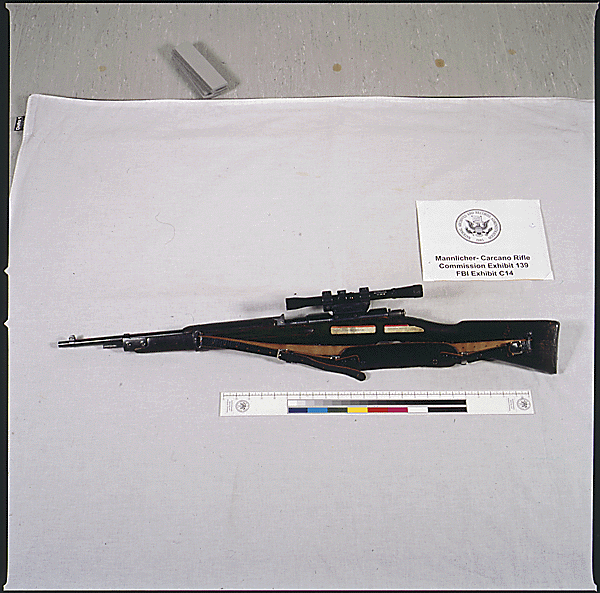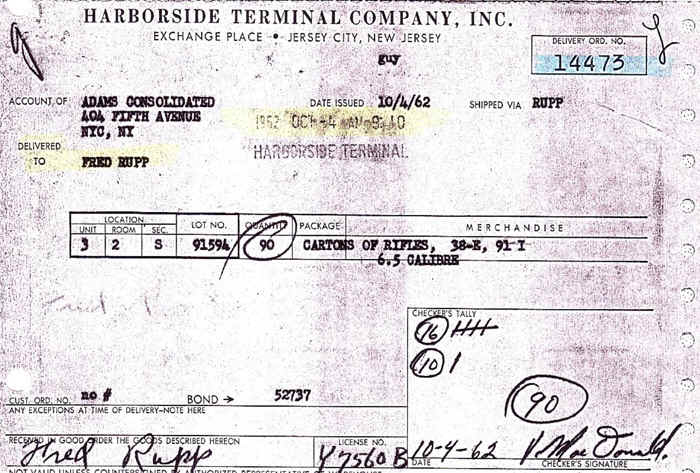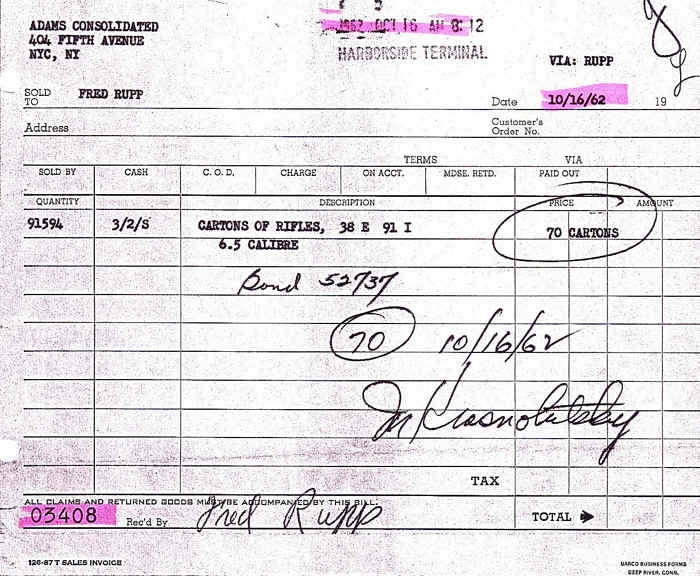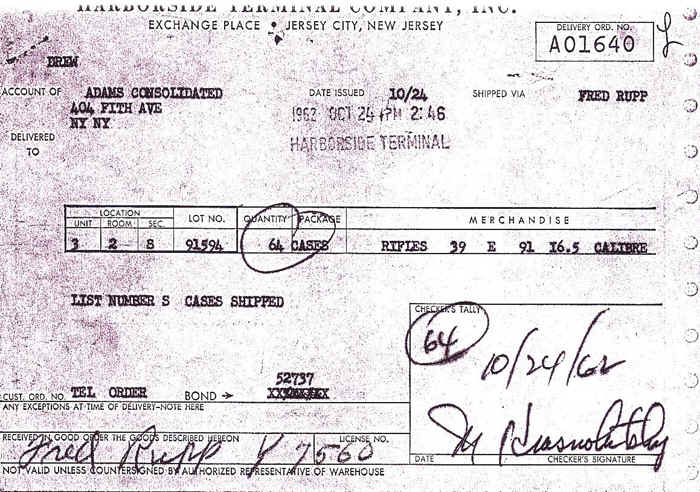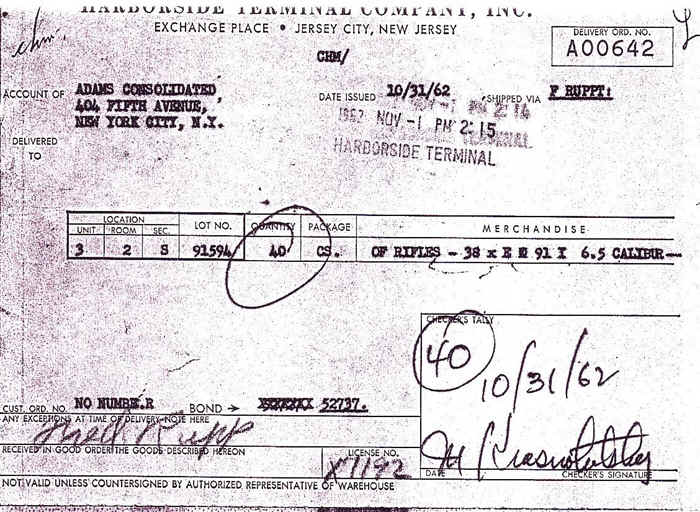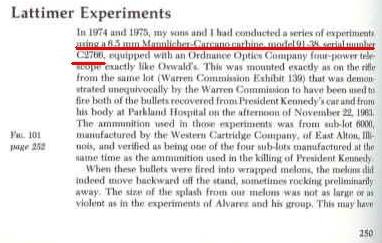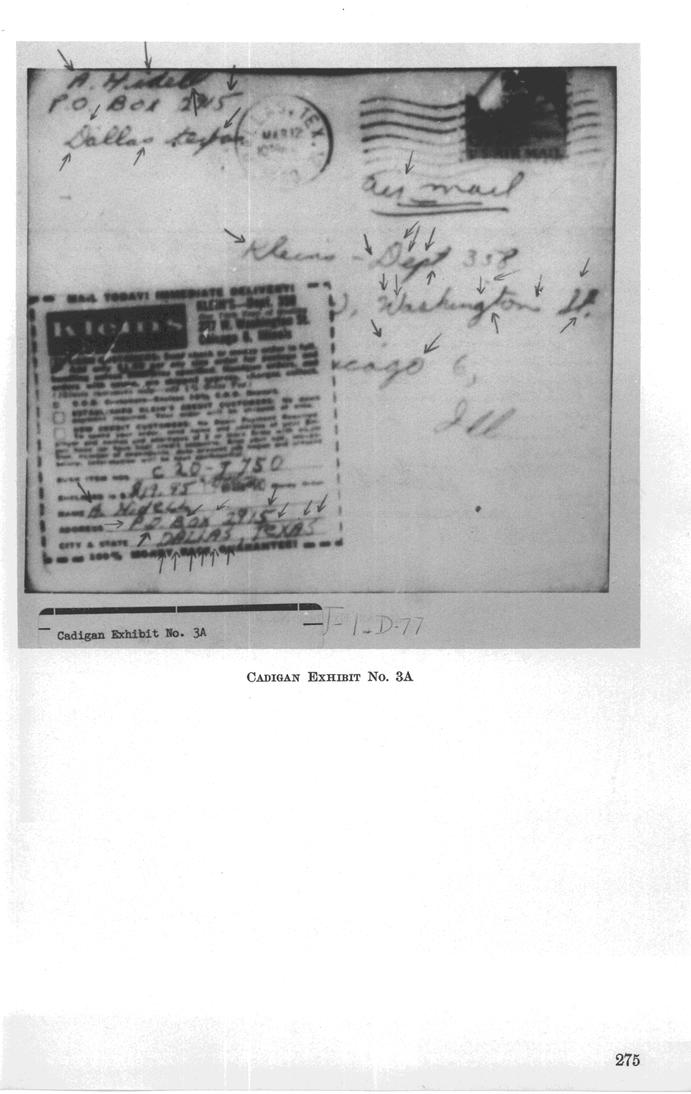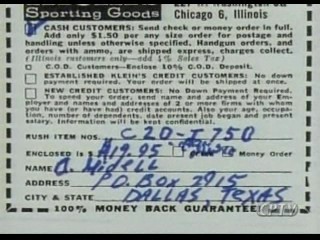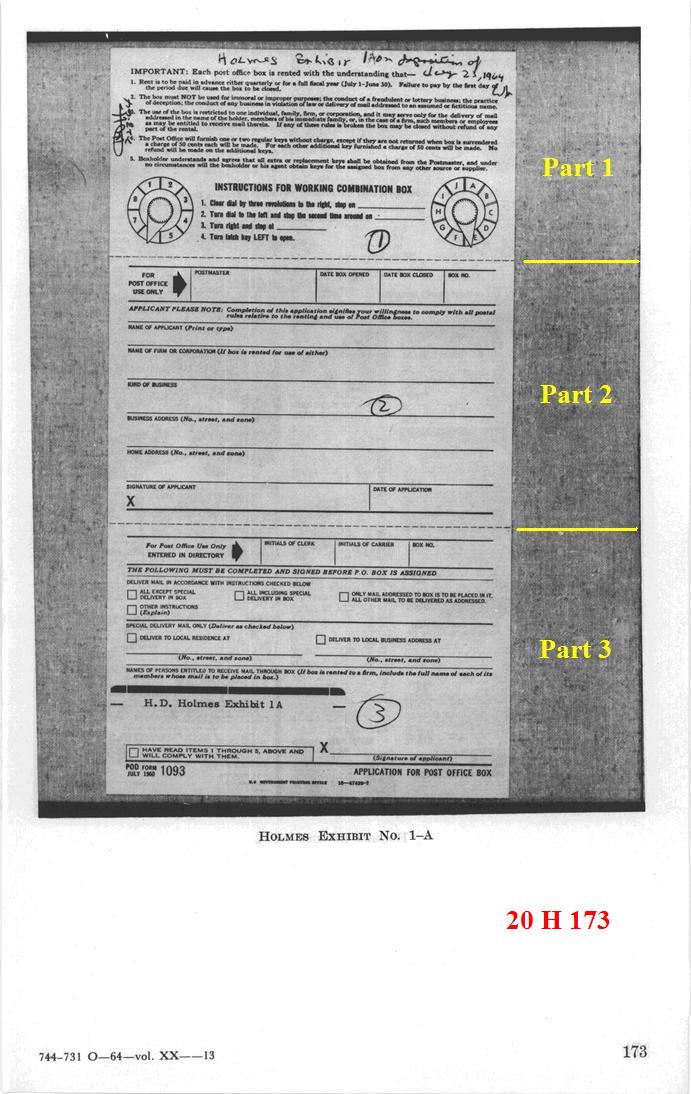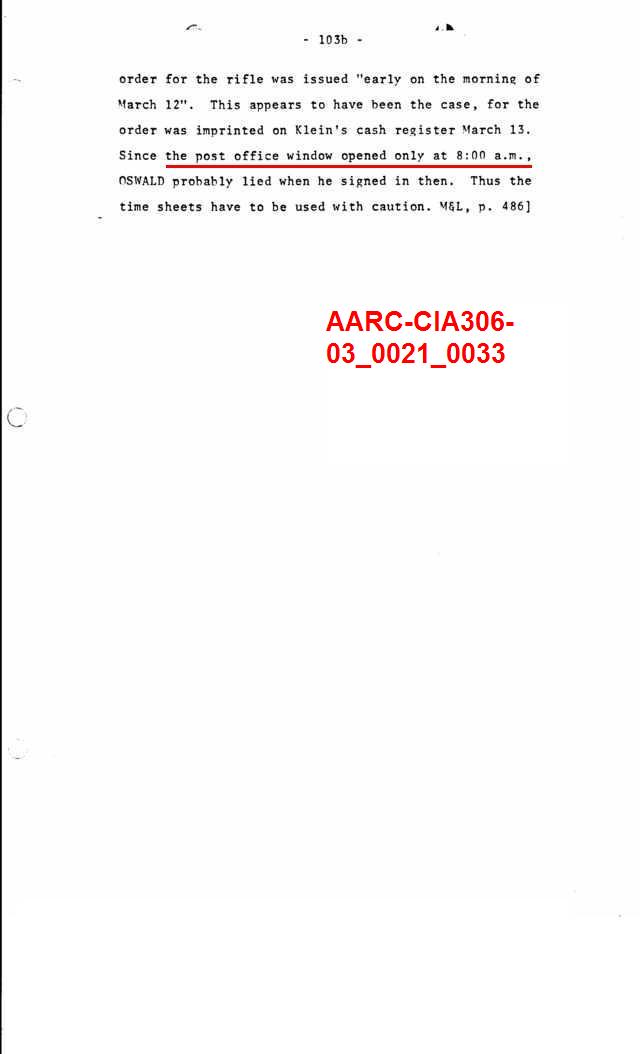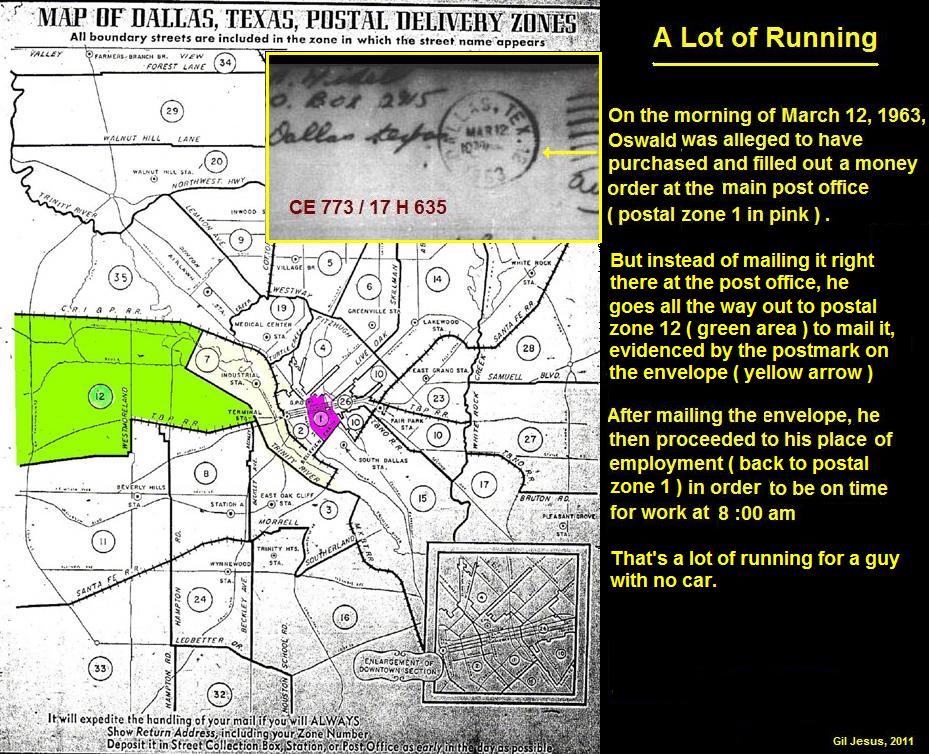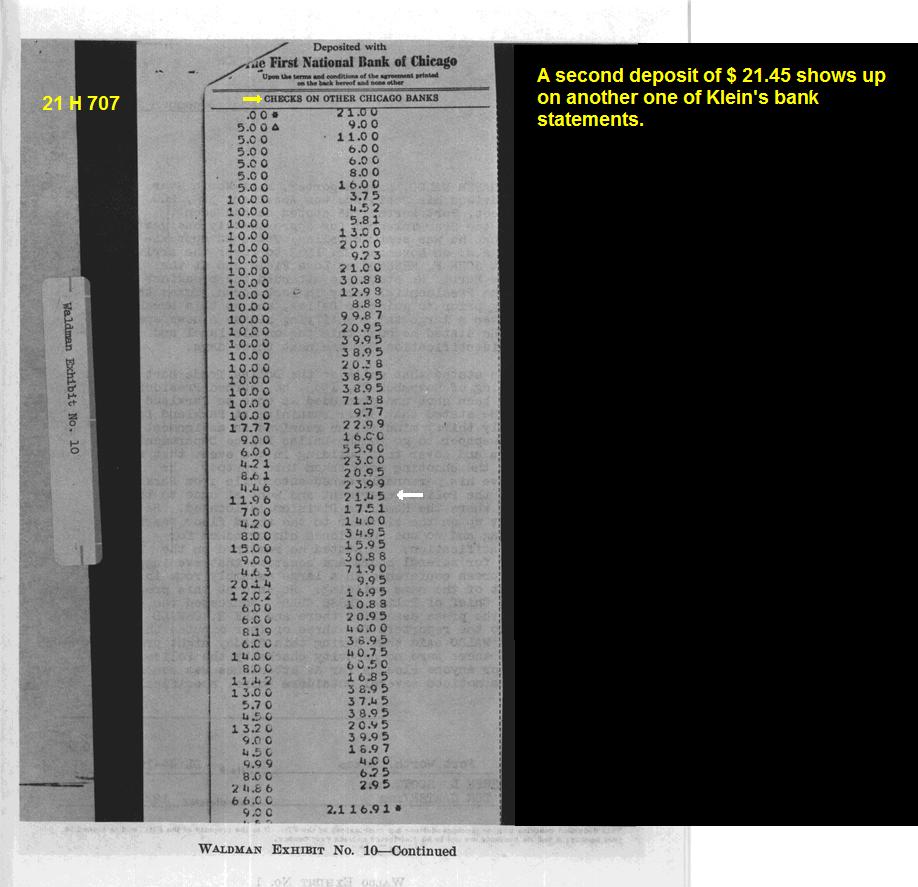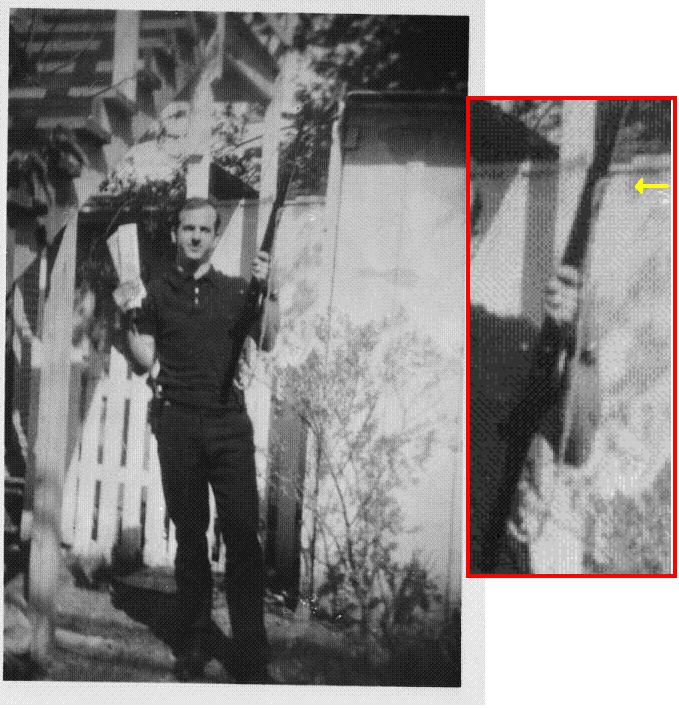
THIS IS A PAGE FROM GIL'S WEBSITE
HERE IS GIL'S COMPLETE WEBSITE>>
|
http://www.youtube.com/user/JFK63Conspiracy VIEW WITNESS AFTER WITNESS ON MARK LANE'S MOVIE |
|
See No Evil Hear No Evil Evidence Oswald did not know the motorcade route Evidence Oswald was "a rather poor shot" Evidence Oswald was on the 1st floor during the shooting W.W. Litchfield Marina Oswald Marina & "Hidell" Problems with Marina's testimony against her husband Proof the Dallas Police falsified evidence against Oswald The "Misfired" Round Bullets in the Pocket Proof the FBI lied in their Reports Proof the Warren Commission predetermined Oswald's guilt The WC alters timing More evidence that Oswald was on the first floor Evidence the "Gunsack was never on the 6th floor Evidence the "Gunsack" was made on the afternoon of 11/22/63 Evidence the rifle was never in the "Gunsack" Evidence the bag Oswald brought to work contained his lunch Evidence Oswald had not fired a rifle Evidence Oswald had not fired a handgun Evidence the Depository rifle was not part of the February shipment to Klein's Evidence that Oswald was at work when the money order for the rifle was purchased and the envelope mailed Evidence that the "$ 21.45" entry on Klein's bank account statement was not the "Hidell" money order Evidence that Oswald's handwriting was easily forgeable Evidence the rifle in the "Backyard Photos" is not the Depository Rifle Evidence that the Depository Rifle had not been fired on 11/22/63 Evidence that Klein's Sporting Goods did not mount the scope on the Depository Rifle
Evidence that affidavits were falsified Ted Callaway Sam Guinyard William Whalley Evidence that the police lineups were unfair Evidence that the Tippit killer's jacket was white News video shows the jacket was white Problems with the gray jacket's chain of custody Evidence that the witnesses described the jacket of the Tippit murderer as white Evidence that the police radio description of the jacket found was white Evidence that the witnesses refused to identify the gray jacket as the jacket the killer wore Skeptical witness identification of the gray jacket as the jacket the killer wore More problems with the evidence The Witnesses
Problems with the Chain of Custody of CE 573 Spectrographic evidence that CE 573 was not the same ammunition fired at JFK Gen. Walker to HSCA: "Walker bullet" not Walker bullet
|
THE RIFLE
".....if Oswald did it with this weapon.....it was an absolute miracle, because no one who knew anything about rifles would have chosen such a decrepit, worthless rifle, as this Italian carbine, manufactured in 1938, for which there is such pure ( poor ) ammunition." ( Testimony of Mark Lane in 2 H 51 ) The Warren Commission concluded that in March of 1963, Lee Harvey Oswald, using the alias, "A.Hidell" ordered a Model 91/38 Italian Mannlicher Carcano bolt-action rifle from Klein's Sporting Goods in Chicago to be delivered to his post office box 2915 in Dallas, Texas. The Commission provided evidence to support its conclusion, including copies of the order blank, money order and envelope filled out by "Hidell". It concluded that Oswald had ordered the weapon from an advertisement in the February 1963 edition of American Rifleman magazine. It was this rifle, the Commission said, a 40.2" weapon bearing serial number C2766, that was found on the sixth floor of the Texas School Book Depository by Dallas Police 45 minutes after the shooting of President Kennedy and Governor Connally.
EVIDENCE THE DEPOSITORY RIFLE WAS NOT PART OF THE FEBRUARY SHIPMENT TO KLEIN'S
TRACKING THE RIFLE
In 1958, Crescent Firearms ( under the name Adam Consolidated Industries ) purchased 500,000 rifles from the Italian Government. The final shipment of those rifles ( 520 cartons ) left Italy's port of Genoa after being identified as lot number 91594 and arrived in the New York via the steamer Elettra Fassio on October 25, 1960. The 520 cartons were removed and trucked by the Waterfront Transfer Company to the Harborside Terminal, a bonded warehouse in New Jersey.
As one can see, the CARTON NUMBERS are
listed on the manifest. For example, "3086/3094" means that all cartons
numbered from 3086 thru 3094 inclusive were on this shipment. The third
entry down, 3305/3436, means that all cartons bearing numbers in that
range were part of this shipment, including the
carton 3376, which allegedly contained a rifle with serial number C2766,
the same serial number as the rifle found on the sixth floor of the TSBD.
According to Harborside delivery order #
89138, Rupp removed the first 170 cartons on August 29, 1962.
Importers of rifles and gun dealers were
required BY LAW to maintain a list of SERIAL NUMBERS of the rifles they
imported. Rupp was required by law to keep a list of the serial numbers
he removed from the warehouse ( which he did on the 8/29/62 manifest )
and the name of the retail customer he shipped them to. And Klein's was
required to keep the serial numbers of rifle they sold to retail
customers. (
7 H 371 )
70 on October 16 64 on October 24 and the last 40 on October 31 On all of the subsequent shipping
manifests of the rifles removed from Harborside Warehouse by Fred Rupp,
THE LIST OF CARTON NUMBERS IS ABSENT,
even though on the 10/24 manifest, it is clearly marked "list numbers of
cases shipped". Rupp removed a total of 434 Mannlicher Carcano 91/38
rifles in the month of October 1962 from the lot of 520 rifles ( 91594 )
belonging to Crescent Firearms. He told the FBI that he kept no record
of the carton numbers or serial numbers of the rifles he removed from
Harborside. (
CD 7, pg. 180 ) In other words, THERE IS NO
EVIDENCE THAT CARTON 3376 WAS AMONG the 434 rifles removed by
Rupp, even though the FBI said it was. The first one is Crescent Firearms invoice # 3178. Of course, it shows no such thing.
Which means that in verifying the carton numbers in that shipment, 3376 was never verified as being a part of that shipment. The FBI's " tracking of the rifle " included unsigned and undated documents and manifests. One such undated and unsigned example of document was Waldman Exhibit 3, the second document the Warren Commission used to "prove" that carton 3376 was shipped to Klein's.
Waldman Exhibit 3 is an undated and unsigned list of ten carton
slips which allegedly made up the February shipment from Crescent to
Klein's. Listed on each of the ten carton slips are the serial numbers
of the 10 rifles in each carton,
including carton 3376. Since there are no dates on any of the slips
in Waldman Exhibit 3, it serves no purpose in proving that carton 3376
and thus the C2766 rifle was part of the February shipment. The slip numbers are 3672, 3504, 4376, 3813, 3789,
3661, 3762, 3544, 3620 and 3770. The Klein's Witness William Waldman was anything but an expert. He knew so
little about the M-C rifle, that when he was shown the order form from
his company to Crescent Firearms, (
Waldman Exhibit 1 ) he testified that the order had been changed
from a 91TS to a 91/38EFF: He never should have been called as a witness in regard to the processing of the rifle sale. In fact, the Commission even had him giving testimony about documents that were clearly from Crescent Firearms. Why would they do that ? Because at Crescent Firearms there WAS someone familiar with rifle sales. But Louis Feldsott was never called to give live testimony before the Commission and only gave a sworn affidavit. In that affidavit, however, Feldsott swore that Crescent's records showed that rifle C2766 was sold to Klein's on June 18, 1962, not in February 1963. Why would that have been a problem ? BECAUSE PRIOR TO 4/13/62, KLEIN'S RIFLE ORDER WAS FOR THE 91/38 TS, WHICH ONLY CAME IN 36" LENGTHS. There's no way that Fred Rupp could have prepared a shipment between 4/13 and 6/18. That's only two months. The February 1963 shipment took him five months to prepare.
That means that if rifle C2766 was sold to Klein's as part of a shipment on 6/18/62 in response to their 1/15/62 order, Rupp would have had to have started preparing the shipment right after the order, and that means that the rifles in that order would have been 36" rifles. Because the order for the 91/38's didn't go into effect until 4/13/62, the order change would have been much too late to have altered a shipment that had already been started and would be delivered on 6/18. In addition, Rupp told the FBI that the rifle bearing serial number C2766 which he serviced was a 36" rifle. ( Armstrong, Harvey & Lee, pg. 446 ) This information is significant, I believe, because it proves that there was more than one rifle, in this case a 36" rifle and a 40.2" rifle, bearing the serial number C2766. The rifle serial numberIt was imperative for the Commission to show that the Depository rifle was the only one with the serial number C2766 in order to establish that that was the rifle shipped to "A. Hidell" at box 2915 in Dallas. In its report, the commission said that, "Information received from the Italian Armed Forces Intelligence Service has established that this particular rifle was the only rifle of its type bearing serial number C2766." ( Chap.4 , pg. 119 ) The Commission went on to say that, "the number "C2766" is the serial number of the rifle, and the rifle in question is the only one of its type bearing that serial number" ( Appendix X, pg. 554 ). The FBI also told the Commission that although rifles might have the same serial number sequence, some were preceded by a letter and some were not ( i.e. 2766 vs. C2766 ). ( 3 H 393 ) If there was ever proof that there was more than one rifle with the serial number C2766, it would come from the most unlikeliest of sources, Warren Commission supporter the late John K. Lattimer. In his book Kennedy & Lincoln ( 1980 ) , on page 250 he alludes to an experiment he did with his sons back in the 70's using a Mannlicher Carcano 91/38 rifle with a serial number of C2766.
The Commission never considered that the serial number of the rifle in evidence may have been modified. Without knowing it as fact, it just stated that "This rifle is the only one of its type bearing that serial number." Even if none of the rifles had duplicate serial numbers, how hard would it have been for someone looking to frame Oswald to have added a final "6" to the serial number "C276" ? The hardest part would have been trying to line up the stamp so the numbers were all in a straight line. Otherwise, the final number may have shown up askew to the rest of the numbers and that would have looked odd.
PURCHASING THE RIFLE
The Order Blank and the Order Form The Warren Commission concluded that Lee Harvey Oswald, using the alias "A. Hidell", ordered the 40.2" Mannlicher-Carcano rifle found on the sixth floor of the Texas School Book Depository by Dallas Sheriff's Deputies shortly after the shooting in Dealey Plaza. He did this, it said, using an order blank from the February 1963 edition of American Rifleman magazine. The FBI traced the dept. number on the order blank, 358, to that particular magazine. The problem with the examination of the handwriting on the order blank will be discussed later on this page. Below is Cadigan Exhibit 3-A, a copy of the envelope and order blank that Oswald allegedly used to order the rifle. It is a copy of a copy, in essence, a copy allegedly made from Klein's microfilm copy.
If Cadigan Exhibit 3-A is a copy of the original order blank, then PBS "Frontline" needs to explain where it got its copy of the order blank from. In a 1988 production of a program called, "Who Was Lee Harvey Oswald", the program showed the order blank, but this time the "A" in the "A.Hidell" was in script, not printed.
So where did this second order blank come from and why did PBS attempt to pass it off as the real deal ? A second issue I have with the order form and the order blank has to do with the catalog number. The catalog number for the rifle in the Klein's ad was C20-T750. It described a 36" rifle ( B, below ), while the catalog number for the 40" rifle, like the one found on the sixth floor of the TSBD, was slightly different, C20-750 ( C, below ). The catalog number for the 36" rifle was on the order blank ( above, Cadigan 3-A ) and the order form ( A, below ). The order form appears to be a document that was generated by the office of Klein's which typed in certain information and then passed it on to the warehouse to fill the order. Klein's control number and the rifle's serial number were then apparently handwritten by warehouse employees whose job it was to fill the orders. So one would have to wonder why the documentation indicates that the order was for a 36" rifle and the order was processed for a 36" rifle but the serial number was of a 40" rifle ? In light of the fact that NONE of the Klein's employees who were responsible for filling the orders or shipping and receiving the weapons were ever called to give testimony to the Commission, is it possible that the documents are not real, but were created after the assassination with the intent on framing Oswald for the crime post mortem ?
Post Office Box 2915 and the Application The application consisted of three parts. The first part included postal rules and instructions for working combination locked boxes. The applicant could throw it away or keep it in his wallet. It included the combination for combination boxes. Parts 2 & 3 comprised the actual application. Part 2 included information on the applicant and his type of business ( if applicable ). Part 3 included special instructions on delivering mail, how to handle special deliveries and listed the names of other people beside the applicant who were entitled to receive mail through the box.
So the question is whether or not "A.Hidell" was authorized to receive mail at Oswald's box 2915 in Dallas. In order for "Hidell" to receive mail there, the evidence shows that his name would have had to have been on the box application. When Dallas Postal Inspector Harry Holmes testified before the Warren Commission, he provided only a copy of part 2 of Oswald's post office box application ( Holmes Exhibit 3, below ). He told the Commission that part 3 had been discarded when the box had been closed, in May 1963, in accordance with postal regulations. Holmes further went on to say that the New Orleans Post Office hadn't complied to the regulation by keeping part 3 of Oswald's box application in that city. ( 7 H 527 ) In it's Report, the Commission repeated Holmes' testimony that the destruction of Part 3 of the PO Box application was in accordance with postal regulations. "In accordance with postal regulations, the portion of the application which lists names of persons, other than the applicant, entitled to receive mail was thrown away after the box was closed on May 1963." ( Report, Ch. 4, pg. 121 ) That was a lie. The postal regulation required that the box application ( parts 2 & 3 ) be kept for a period of 2 years after the box was closed. In 1966, author Stewart Galanor decided to write to the US Post Office and ask two questions. The first was regarding the post office box application and how long the record was to be kept. The second question regarded what happened to mail that was addressed to someone NOT on the box application part 3. In response to the first question, the post office replied that in March of 1963, postal regulation 846.53h required that all box applications, including part 3, be kept for a period of 2 years after the box was closed.
Of course, this revelation alone makes a liar out of Harry Holmes. It shows that the New Orleans PO was in compliance with the postal regulation and the Dallas PO was NOT. As if that wasn't bad enough, Holmes also lied about how mail addressed to persons whose names were NOT on the post office box application was handled. He told the Commission that when the post office received mail or a package addressed to someone NOT on the application, a notice would be put in the box REGARDLESS OF WHOSE NAME WAS ON THE MAIL and when someone came to the desk with the notice, they got the mail/package, REGARDLESS OF WHO THEY WERE. ( 7 H 527-528 ) In order to show how ridiculously absurd such a procedure is, the Post Office regulation is clear. In response to Mr. Galanor's second question, regarding mail addressed to someone NOT on the box application part 3, the post office replied that regulation 355.111b(4) required that the item would have marked "addressee unknown" and returned to sender.
In other words, if "Hidell's" name is not on the box application part 3, he CANNOT receive mail in a box assigned to Oswald.
EVIDENCE THAT OSWALD WAS AT WORK WHEN THE MONEY ORDER FOR THE RIFLE WAS PURCHASED AND THE ENVELOPE MAILED
Buying and Mailing the Money Order The next problem with the purchasing of the rifle is that at the date & time Oswald was alleged to have purchased the money order he allegedly used to pay for it and mailed the envelope containing it, he was at work at Jaggars-Chiles-Stovall. The money order was stamped that it had been purchased on March 12, 1963 and the envelope it was allegedly mailed in had a postmarked time of 10:30 am, meaning that IF Oswald bought he money order, filled it out and mailed it, he had to have accomplished it between the time the Post Office opened and the postmarked time.
The problem comes in when we examine Oswald's work timesheet from Jaggars-Chiles-Stovall for March 12, 1963, the date the money order was allegedly purchased. Below is Commission Exhibit 1855 and it shows that DURING THE TIME OSWALD SHOULD HAVE BEEN PURCHASING, FILLING OUT AND MAILING THE MONEY ORDER FOR THE RIFLE, HE WAS AT WORK. ( red box )

In fact, the document shows that excluding Oswald's lunch break from 12:15-12:45pm, EVERY SINGLE MINUTE OF OSWALD'S DAY IS ACCOUNTED FOR FROM 8:00am THROUGH 5:15pm. And there is NO EVIDENCE that Oswald was late for work that day. In fact, according to his boss at JCS, he was "very punctual".Mr. JENNER. Was he regular in his arrival at work? Mr. GRAEF. Yes. Mr. JENNER. Were his work habits in that connection satisfactory? Mr. GRAEF. Yes. I would say he was very punctual in his arrival to work. ( 10 H 184 ) There is also NO EVIDENCE that Oswald received a ride to work that day from a co-worker. There IS EVIDENCE from testimony, however, that when co-workers offered rides to Oswald, he declined. Mr. OFSTEIN. ..............he was also offered
rides by Mr. Graef, and I offered him a ride a couple of times either to
his home or wherever he wanted to catch a bus, and I know that he always
declined my offer of a ride. Mr. JENNER. What did he say? Mr. OFSTEIN. He said; no, he would go ahead and walk, and usually in the evening when he would leave he would say, "I am going up to the post office to pick up my mail, and a couple of times I would offer to give him a ride up this way, as it wasn't much out of my way and I have to come in this direction anyway to Live Oak before I turn, which is only about a block difference, and he always declined to ride and would walk. ( 10 H 205 ) Amazingly, not one single witness was ever called to testify about Commission Exhibit 1855 and there is NO MENTION of this document in ANY of the 15 volumes of testimony. In addition, there is NO EVIDENCE that the Main Post Office opened before 8am, allowing Oswald to make his purchase prior to going to work. In fact, this document found in Box 50 of the HSCA Segregated CIA files shows that the post office window opened at 8:00 am:
The document states that Oswald "probably lied" when he signed in on his timesheet and cautions that the "time sheets should be used with caution". PROBABLY lied ? "Probably" is one of those "buzz words" people use when they don't have any evidence. Like "could be", "maybe" and "possibly". The fact is there's no evidence that Oswald lied on his timesheet. There's no evidence that Oswald was late for work on March 12th. And there's no evidence that Oswald was at the post office at 8:00 am. We know the post office window opened at 8:00 am and the record shows that Oswald was at work at 8:00 am. The burden of proof is on Oswald's accusers: if they can prove that Oswald was not at work and at the post office at 8 am on March 12, 1963, let's see their evidence.
As if Oswald not having the time to purchase, fill out and mail the money order wasn't enough, the next problem is that the money order was not mailed at the post office from where it was purchased, but it was mailed instead THREE POSTAL ZONES AWAY. An examination of the postmark on the envelope indicates that it was mailed in postal zone 12 ( yellow arrow ) , when Oswald worked and allegedly purchased the money order in postal zone 1. And there is NO EVIDENCE that Oswald gave the envelope to someone else to mail.
Processing the Money Order Another problem, this one of the money order itself ( CE 788, below ) is that it contained no stamp from any financial institution. The only stamp on it was a stamp on the back from Klein's Sporting Goods for deposit into its account ( number 50-91144 ) in the First National Bank of Chicago. ( red arrows below )
Bank stamps were used on postal money orders in those days as is evidenced by the referral to same ( "bank stamps are not regarded as endorsements" ) on the back of the money order. The single stamp on the back was identified in testimony as the stamp of Klein's.
Financial institutions stamp checks and money orders in order to ensure that each institution pays only once on each item. Without the stamp, there's no proof that the money was actually paid by the bank and credited to the customer's account. The stamps also assist law enforcement in tracking finances in criminal cases. This money order should have had on it the DATED stamps of all financial institutions that handled the document. The fact that it doesn't is proof that it never passed through the Federal Reserve System. Postal Money Orders received by the First National Bank of Chicago, were then sent to the Federal Reserve Bank, also in Chicago. The First National Bank did NOT microfilm money orders. To confound the tracking of the money order, the Federal Reserve Bank in Chicago kept records of money orders for only six months, which means that it too had no record of this particular money order. At the time the money order would have been processed, 75% of money orders were being sent to Washington, D.C. and the other 25 % were being sent to Kansas City, Missouri. Lester Gohr of the Federal Reserve Bank in Chicago provided the FBI with the addresses of both locations. ( CD 7, pg. 193 ) So far, in tracking the money order, this is what we have: The money order with a stamp for Klein's Sporting Goods for deposit into its account into the First National Bank of Chicago. No evidence that it was received by the bank. No evidence that it was received by the Federal Reserve Bank of Chicago. No evidence that it was received by any financial institution in either Kansas City or Washington, D.C. And yet, this "magic money order" is able to find its way through the Federal Reserve System WITHOUT ANY ENDORSEMENTS from the financial institutions which handled it. Not surprizingly, this money order without bank stamps becomes part of a deposit which never included it.
EVIDENCE THAT THE "$ 21.45" ENTRY ON KLEIN'S BANK STATEMENT WAS NOT THE "HIDELL" MONEY ORDER
The Klein's deposit & its deposit slip Still another problem with the purchasing of the rifle involves the alleged deposit of the "Hidell" money order by Klein's Sporting Goods. Waldman 10 shows that the $13,000 deposit had a deposit slip of 2/15/63. If you look at that exhibit, you'll see that the date at the bottom of the bulk statement is the date "3-13"63". I believe that these two documents represent a deposit which was made on 2/15/63, the bulk list being a bank statement of account action for the period ending 3/13/63.
Before the naysayers respond that the deposit slip
could have been in an honest mistake, I would like to point out that
BOTH the month AND the day are wrong ( if you buy the deposit being made
on 3/13/63 ). I could see an error on the month at the beginning of the
month, but an error on the MONTH AND DAY in the
MIDDLE of a month ? Let me explain why I believe that. I believe that we're looking at TWO documents, dated a
month apart, for the SAME deposit. the first is the February 15, 1963
deposit slip with a total of $ 13,827.98 in deposits from Klein's
sporting goods to be deposited into their account in the First National
Bank of Chicago. (
21 H 706 )
Unfortunately, the date for this second "deposit" is
cut off, making it impossible to determine its exact date. It seems to me, looking at the evidence, that Klein's
never had a deposit of $ 21.45 in March of 1963 but had 2 in February. Again, that's my opinion, based on what I've seen. Absent the dated stamp of the bank, it was IMPOSSIBLE to say when and IF the money order had been deposited. It was particularly difficult for Waldman in his testimony to nail down the WHEN. Mr. WALDMAN. ..... Now, we cannot
specifically say when this money order was deposited, but on
our deposit of March 13, 1963, we show an item of $21.45, as indicated
on the XEROX COPY OF OUR DEPOSIT SLIP marked, or IDENTIFIED by--AS
WALDMAN DEPOSITION EXHIBIT No. 10. Needless to say, Robert Wilmouth never appeared on the FBI's witness list to testify before the Commission and identify the "Hidell" money order as having passed through his bank, either in live testimony or by deposition. If the deposit was made in February, as I suggest, then the $ 21.45 in Waldman 10's deposit of $ 13.827.98 couldn't possibly be the "Hidell" money order . And there's evidence showing that it wasn't. In Commission Document 7, pg. 192 ( below ) , Wilmouth
told the FBI that there were TWO deposits of $
21.45 and the one in the $ 13,827.98 deposit ( Waldman 10 ) was an
American Express money order, NOT the postal money order sent by "A.Hidell".
He said that "the item appeared on a tape between an item of $ 15.08 and
an item of $ 14.36, precisely where David Belin put a mark on Waldman
10.
Finding the money order HARRY HOLMES TESTIFIED THAT THE MONEY ORDER STUB WAS FOUND AT 12:10
PM ON 11/23/63:
RECEIVING THE RIFLE
The Federal Firearms Act of 1938 said that "Nobody is permitted to ship, transport, or cause to be shipped or transported, in interstate or foreign commerce, any firearm or ammunition to any person, knowing or having reasonable cause to believe that such person is a fugitive or is under indictment for, or was convicted of a crime of violence." In order to prove that a weapons customer wasn't a fugitive or violent criminal, Texas law REQUIRED that a "certificate of character" be issued by a judge in the county of residence of the purchaser of a firearm. ( VERNON'S TEXAS PENAL CODE, article 489a ( 1925 ) ) No "certificate of character" exists for the sale of the rifle. In addition, no clerk in the Dallas Post Office has ever come forward admitting that they handed a long package to Oswald in March of 1963. In other words, there's no documented evidence or eyewitness account proving that anyone ever took possession in March of 1963 of a rifle that had been received at Post Office Box 2915 in Dallas. In addition to the envelope being mailed at a time when Oswald was at work, being mailed three postal zones away, not having a bank stamp on it, being included in a deposit that it was clearly not a part of, missing part 3 of the post office box application and the "certificate of character" required by law, the lack of evidence that anyone physically took possession of the weapon from the post office and the unbelievable amount of time it took to find the money order after the discovery of the stub, there seems to be only one area of the purchasing of the rifle left to destroy.
OSWALD'S HANDWRITING
Two experts gave testimony to the WC concerning questioned documents: Alwyn Cole and James C. Cadigan. Cole apprenticed as a questioned document examiner for 6 years, from 1929 to 1935, and had been an examiner of questioned documents for the U.S. Treasury Department since then. Cadigan had been a questioned document examiner with the FBI for 23.5 years, following a specialized course of training and instruction. Both had testified many times in Federal and States courts. ( WCR, App. X, pg. 566 ) Their conclusions were identical. The mail order and envelope for the C2766 rifle were photographed by Klein's on microfilm, and then destroyed. ( ibid., pg. 569 ) The money order was never microfilmed. In his testimony, Cadigan was careful to say that CADIGAN 11 had been prepared by LHO and NOT CE 788. The reason he said it that way is because Cadigan never compared the ORIGINAL, CE 788, to Oswald's handwriting. He compared a PHOTOGRAPH of CE 788, which was Cadigan 11. ( 7 H 423 ) Likewise, Cole examined a COPY of the original, which is CE 789, and
not the origin, CE 788. (
4 H 374 ) And for that matter, neither Cole nor Cadigan was asked any technical
questions about the photos even though they admitted supervising their
creation. Instead of photographic technicians, the legitimacy of the
photographs were confirmed VISUALLY by the examiners, Cadigan and Cole. Both Cole and Cadigan testified that the photographs they examined were clear enough to permit an identification through examination. Their opinions covered both the copies of the standards ( the known handwriting of Lee Harvey Oswald ) and the copies of the questioned documents, like the money order. "Standards" are the known, verifiable handwriting samples that are compared to the disputed handwriting. It is important to remember that, in an examination involving disputed handwriting, the standards will make or break your case. If the examiner has poor standards, this will impact the strength of the opinion. The standards should be relevant, contemporaneous, in sufficient numbers and, as always, ORIGINAL DOCUMENTS. http://www.forgeryfinder.com/Standr.htm Many of the standards in the examination of Oswald's handwriting were COPIES. Signature and other handwriting identification problems examined from photocopies limit the ability of the forensic document examiner to observe evidence such as speed of execution, lifts of the writing instrument, pauses of the writing instrument and other important evidence. Reproductions from microfilm or microfiche tend to be of LESSER quality than standard photocopies. http://www.osbornandson.com/examphoto.html The "Oswald" documents were copies made from microfilm. The House Select Committee on Assassinations examined the Oswald handwriting using a three member panel consisting of Joseph P. McNally, David J. Purtell, and Charles C. Scott. The conclusions of the HSCA panel confirm that there are problems with comparing copies with originals. Scott concluded that while all of the original handwriting purported to be Oswald's was made by the same person, only a "tentative opinion" could be reached as to the reproductions. ( 8 HSCA 247 ) McNally agreed, saying that while the writing on the envelope and the money order matched, there was a caveat ( condition ) that the writing on the envelope was a photo reproduction from microfilm. ( 4 HSCA 355 ) Earlier he explained why the "qualifying" identification when discussing the panel's examination of Oswald's Cuban visa application. He said that because it was not an original document, it "could not be examined microscopically". ( ibid. ) During his testimony, McNally was forced to admit that copies were never as good as originals for handwriting comparison: Mr. FAUNTROY. Are photocopies as good as original handwriting for
analysis purposes? David Purtell said, "Photocopies have several limitations. They do not reproduce all
the fine details in handwriting needed in making an examination and
comparison.....Document examiners only render a qualified or conditional
opinion when working from copies. They stipulate that they have to
examine the original before a definite opinion will be made."
Purtell explained further: "....it is possible to incorporate or insert changes and alterations into copies. A method frequently used is to paste together parts of documents to make one fradulent document, which is then copied. If the first copy can pass inspection, it will be used; if not, it will be reworked to eliminate all signs of alteration. This amended copy is then recopied for the finished product. This is usually referred to as the "cut and paste" method." ( 8 HSCA 239 ) In addition, the ease with which an individual can reproduce an original genuine writing from one document onto another document using the photocopier is always a consideration. It is possible to make such a transfer with little or no evidence which would reveal such a fraudulent preparation. http://www.osbornandson.com/examphoto.html Finally, we should always keep in mind that a document examiner's conclusion is correctly considered a professional opinion, not evidence. http://www.forgeryfinder.com/Hand.htm
EVIDENCE THAT THE DEPOSITORY RIFLE IS NOT THE RIFLE IN THE FAMOUS "BACKYARD" PHOTOGRAPHS
The Sling Mount One of the inconsistencies in the evidence regarding the rifle is the obvious difference in the sling mounts between the rifle found one the sixth floor of the Texas School Book Depository and the rifle depicted in the famous "backyard photographs", CE 133-A thru C. As the reader can see, the Depository rifle, CE 139, had side mounts for the sling both front and rear:
While the rifle in the backyard photos obviously has a bottom mount for the sling in front.
It appears that the rifle in the BY photos has a front sling mount similar to the one depicted below, but with a "D" ring added.:
CE 133-B also shows the "rope sling" apparently tied to the bottom of the front of the rifle. Had it been tied to a front side sling mount, the knots ( yellow arrows, below ) especially the rear knot, would have been on the "Oswald side" of the rifle and out of the camera's view:
Likewise, CE 133-C also shows the rope tied to the bottom of the rifle at the front ( yellow arrow, below ) and not the side.
Although some may argue that the rear sling mount was attached to the side, whether or not it was is irrelevant because the Depository rifle did not have two different types of sling mounts. What IS relevant is the difference between the front sling mount which is on the bottom in the backyard photos and the front sling mount on the Depository rifle which is on the side. Lyndal Shaneyfelt, the FBI photography expert testified that he had taken photographs of CE 139 ( the depository rifle ) and compared them to the rifle in CE 133-A ( the "backyard photo" ). He told the Commission: "...I did not find any really specific peculiarities on which I could base a positive identification to the exclusion of all other rifles of the same general configuration." ( 4 H 281 ) In other words, he couldn't positively identify the Depository rifle as the one in the "backyard photograph". Big surprise, huh ? But wait, we're not done yet. The House Select Committee on Assassinations Photographic experts found that in examining the photos, there were distinctive marks on the rifle in the DeMohrenschildt and CE 134 ( large photo, above ) BY photos that matched the Depository rifle. ( 2 HSCA 428 ) What about the difference in the sling mounts ? It was never addressed. It would seem that IF Oswald ordered a 36" rifle and received a 36" rifle, then the 40" Depository rifle was not his. You can see more info on the difference in the sling mounts on this video from my youtube channel.
EVIDENCE THAT THE DEPOSITORY RIFLE WAS NOT FIRED ON NOVEMBER 22, 1963
Normally, an investigator examining a weapon to determine if it has been fired, will look first at the outside of the weapon. A visual examination of the condition of the weapon, including an examination of the condition of the firing pin. Next, he examines the inside of the weapon, checking the inside of the barrel and examining the inside of the operating mechanism, the bolt and its parts. In his testimony, FBI firearms expert Robert Frazier testified that he observed that the inside of the barrel of the Depository rifle was "roughened from corrosion", then connected the "corrosion" to rust with his comment that "if a barrel is allowed to rust, one round will remove that rust." So how could the barrel have surface rust after THREE rounds had been fired through it ?
The Rusted Barrel Mr. FRAZIER. The stock is worn, scratched. The bolt is relatively smooth, as if it had been operated several times. I cannot actually say how much use the weapon has. had. The barrel is--was not, when we first got it, in excellent condition. It was, I would say, in fair condition. In other words, it showed the effects of wear and corrosion. ( 3 H 394 ) Frazier was then asked to be more specific on the condition of the rifle barrel when he first got it for inspection. Mr. McCLOY. When you examined the rifle the first time, you said that it showed signs of some corrosion and wear? Mr. FRAZIER. Yes, sir. Mr. McCLOY. Was it what you would call pitted, were the lands in good shape? Mr. FRAZIER. No, sir; the lands and the grooves were worn, the corners were worn, and the interior of the surface was roughened from corrosion or wear. Mr. McCLOY. Could you say roughly how many rounds you think had been fired since it left the factory, with the condition of the barrel as you found it? Mr. FRAZIER. No, sir; I could not, because the number of rounds is not an indication of the condition of the barrel, since IF A BARREL IS ALLOWED TO RUST, ONE ROUND WILL REMOVE THAT RUST and wear the barrel to the same extent as 10 or 15 or 50 rounds just fired through a clean barrel. ( 3 H 395 ) Frazier KNEW when he visually inspected the rifle that rust in the barrel meant that the rifle had not been fired, because just one round fired through it would have removed all rust. The fact that he visually saw rust in the barrel made it clear to him that there was no need to conduct a "swab test" to test for metal shavings and fouling in the barrel. Mr. McCLOY. Was there metal fouling in the barrel? Mr. FRAZIER. I did not examine it for that. ( ibid. ) Had Frazier visually examined the barrel and found no rust, it would have been standard procedure to next do the "swab test" to determine if there was no rust because the barrel was clean or because a bullet had passed through it. The "swab test" would have detected any metal shavings from the bullet's jacket and gunpowder residue ( fouling ). A clean swab from a barrel with no rust would have proven the rifle had not been fired, while a swab with residue would have proven that it had. The ONLY thing that would have prevented Frazier from doing the swab test would have been if his visual inspection had revealed that the inside of the barrel was rusted and thus that no bullet had passed through the barrel in the last 24 hours. If there is any question as to whether or not the inside of the barrel was susceptible to rust, that question was answered by the Firearms Panel of the House Select Committee on Assassinations in the 1970's. The Panel examined the C2766 rifle before it did any test firing and reported the rifle's condition: "A visual examination of the rifle revealed pitting, rust and copper oxidation to test-firing, which the panel believed should be removed prior to test-firing. Accordingly, a dry cloth patch was pushed through the bore. ( 7 HSCA 365 ) So the inside of the barrel ( "the bore" ) showed "pitting, rust and copper oxidation" as a result of the rifle having not been fired since the last "test-firing", some 13 years previously. This is what happened to this barrel from non-use --- it rusted. But it wasn't the only part of the rifle which contained rust.
The Rusted Bolt Not only was there rust on the inside of the barrel, rust that should not have been there if the rifle had been fired ONCE ( never mind THREE times ), Ronald Simmons' testimony indicates that the bolt was also rusted: Mr. EISENBERG. Did they make any comments concerning the weapon? Mr. SIMMONS. Yes; there were several comments made particularly with respect to the amount of effort required to open the bolt. As a matter of fact, Mr. Staley had, difficulty in opening the bolt in his first firing exercise. He thought it was completely up and it was not, and he had to retrace his steps as he attempted to open the bolt after the first round. ( 3 H 447 ) The obvious way of "getting the rust out", is by operating the bolt in a "dry run ". They unloaded the weapon and each shooter "worked" the bolt back and forth in a "practice exercise" for 2-3 minutes BEFORE he began firing. The firing pin was rusted so badly, that they were afraid it might break. Mr. EISENBERG. How much practice had they had with the weapon, Exhibit 139, before they began firing? Mr. SIMMONS. They had each attempted the exercise without the use of ammunition, and had worked the bolt as they tried the exercise. They had not pulled the trigger during the exercise, however, because we were a little concerned about breaking the firing pin. Mr. EISENBERG. Could you give us an estimate of how much time they used in this dry-run practice, each? Mr. SIMMONS. They used no more than 2 or 3 minutes each. (ibid.) They worked the bolt for a total of 6-9 minutes to free it from its rust. The bolt was so rusted that operating it tended to move the rifle off target. Of course, the more you use the bolt, the freer from it becomes and the faster the elapsed times are for the shooters. Mr. SIMMONS. .....the pressure to open the bolt was so great that we tended to move the rifle off the target, whereas with greater proficiency this might not have occurred. Mr. EISENBERG. Could this experience in operating the bolt be achieved in dry practice, Mr. Simmons? Mr. SIMMONS. Yes; it could be, if sufficient practice were used. There is some indication of the magnitude of change with one of our shooters who in his second attempt fired three-tenths of a second less time than he did in the first. ( 3 H 449 ) The rusted firing pin, & spring
Then there was enough rust on the firing pin and its spring for someone to have oiled it: ".....the firing pin of this rifle has been used extensively as shown by wear on the nose or striking portion of the firing pin and, further, THE PRESENCE OF RUST ON THE FIRING PIN AND ITS SPRING....." ( CE 2974 )
CE 2974 states that there was rust on the firing pin of the rifle and "This rust would have been disturbed had the firing pin been changed...". What the FBI was saying is that there was "undisturbed rust" on the firing pin. That rust would have been disturbed if the firing pin had moved in the previous 24 hours. So how is there rust on a firing pin that has been used three times in the last 24 hours ? This document also states that not only was "the firing pin and spring of this weapon well oiled", the rust "must have formed prior to the oiling of these parts." Rust could not have formed on the rifle AFTER the assassination. Frazier testified that he examined it on the day after Kennedy was murdered, not enough time for rust to have settled in: Mr. McCLOY. How soon after the assassination did you examine this rifle? Mr. FRAZIER. We received the rifle the following morning. Mr. McCLOY. Received it in Washington? Mr. FRAZIER. Yes, sir. Mr. McCLOY. And you immediately made your examination of it then? Mr. FRAZIER. We made an examination of it at that time, and kept it temporarily in the laboratory. ( 3 H 395 ) Frazier testified that when he examined the rifle the FIRST TIME, on the day after the assassination, he found that the inside of the barrel had been "roughened" by corrosion and wear. Then he referenced the effect of what ONE SHOT would have on a rusted barrel. Why would he do this if the "roughened surface" he saw on the inside of the barrel wasn't rust ? What connection could there be between a rusted barrel and the "roughened" barrel of Oswald's rifle other than that the two were both rusted ? If the inside of the barrel of the Depository rifle was rusted or had rust in it, then NOT A SINGLE ROUND HAD BEEN FIRED FROM IT IN THE PREVIOUS 24 HOURS. Meaning that it had not been fired. Meaning that it wasn't the murder weapon. Now you know why the FBI never did a "swab test" of the inside of the barrel to determine if the rifle had been fired. A swab test would have detected copper fouling in the barrel. With a rusted barrel and undisturbed rust on the firing pin, there was no need to check to see if the rifle had been fired recently. Mr. McCLOY. Was there metal fouling in the barrel? ( ibid. ) Robert Frazier's testimony suggests that the rifle he saw on November 23rd had rust in the barrel. When he saw that there was rust in the barrel and rust on the firing pin and spring, he knew that the rifle had not been fired. So he had no reason to check the barrel for metal fouling. They knew that this weapon had not been fired, so they sent it back to the Dallas Police. Ronald Simmons' testimony is even more compelling regarding the issue of rust, this time, with the bolt. Simmons testified that the bolt was so difficult to operate that the shooters had to take 2 or 3 minutes before shooting to work the bolt back and forth in a "dry-run exercise", exactly like one would use to loosen a rusted part. The ease of operation of the bolt was essential in their attempts to obtain the elapsed time required for one gunman to have performed the killing. There is no way that one gunman, whether it was Oswald or one of the rifle "experts" else, could have fired three shots from that rifle in the required time with the bolt in the condition as Simmons described it. Oil evaporates. It goes from a thick liquid when first applied, to a thin film. The fact that the pin and spring were "well" oiled indicates that evaporation was not complete, i.e., that the oil had been applied rather recently. The point is, that if oil was added to the rifle AFTER it was rusted, it must have been rusted pretty badly. It all adds up to this: The condition of the rifle that the Dallas Police sent to the FBI on the night of the assassination was such that it was not capable of performing the assassination of President Kennedy and the wounding of Governor Connally. The FBI knew this and sent it back to the Dallas Police.
EVIDENCE THAT THE SCOPE ON THE DEPOSITORY RIFLE WAS NOT MOUNTED BY KLEIN'S
As I've already shown above, the ad that the Commission says Hidell/Oswald ordered his rifle from was for the 36 inch length MC that was offered with the scope. The Klein's employee who originated the idea of mounting a scope on the rifle was Mitchell Westra. He told the House Select Committee on Assassinations (HSCA) that during March 1963, Klein's only mounted the scope on the 36 inch MC.
The man who actually mounted the scopes for Klein's was Bill Sharp, their in-house gunsmith. He confirmed to the HSCA what Westra told them: the March 1963 package deal with the scope was for the 36 inch MC ONLY. Confirmation that Klein's did not mount scopes on the 40" rifle came in the testimony of FBI firearms expert Robert Frazier, who told the Warren Commission that when the FBI ordered a duplicate rifle to the Depository rifle from Klein's, they had to tell them where to put the mount for the scope: Mr. FRAZIER. We contacted the firm, Klein's
Sporting Goods in Chicago, and asked them concerning this matter to
provide us with a similar rifle mounted in the way in which they
normally mount scopes of this type on these rifles, and forward the
rifle to us for examination. ( 3 H 396 ) Why would the FBI have to tell Klein's where to mount the scope if Klein's normally mounted scopes on these rifles ?
MORE TO COME
NOTABLE NOTES FROM THIS PAGE
The envelope containing the money order was mailed from a postal zone that was 3 zones away from the main post office and Oswald's place of employment at a time when Oswald was documented at work. The money order in evidence was not stamped by any financial institution that handled it and passed through the Federal Reserve System without any stamps at all.. The VP of Klein's bank told the FBI that the "$21.45" item on the tape ( Waldman Exhibit 10 ) between the $15.08 and $14.36 items was an American Express Money Order. This is the same one the WC claimed was the "Hidell" postal money order. Using only manual labor and the money order amount as a guide, the Dallas Post Office employees found the money order stub in ten minutes, but it took an IBM computer in Washington 7 hours to find the money order with the number, amount and date info. Part 3 of Oswald's Post Office Box application was destroyed in violation of Federal postal regulations. Postal forms ( delivery receipt, seller's statement ) required to be filled out for firearms sales were never filled out for the rifle sale. A "certificate of character" from a judge in the county where "Hidell" lived was also required for the purchase of the rifle. No such certificate exists. The Klein's catalog number of the rifle "Hidell" ordered was different than the catalog number of the rifle found on the sixth floor of the TSBD. The WC experts comparing Oswald's handwriting used first and second
generation COPIES, rather than original documents. The HSCA experts also
used copies but explained the problems when not using originals. The sling mounts on the Depository rifle are not the same as the sling mounts on the rifle depicted in the famous "backyard" photographs.
|
|
PROOF THE FBI THREATENED WITNESSES
W.W. Litchfield The FBI threatened witnesses who were positive about things they had seen with "federal charges" if the things they were reporting ended up not being the truth. The proof that witnesses were threatened comes from the testimony of W.W. Litchfield II, who told the FBI that he saw a man who looked like Oswald in the Carousel Club.
He told the Commission that the FBI threats definitely had an effect on how he answered their questions: Mr. HUBERT. I gather that you were more positive of the identity of Oswald as being the man in the Carousel on the occasion we have been speaking about at one time than you are now? Mr. LITCHFIELD. I was; yes. Mr. HUBERT. What has caused your opinion in the matter to weaken? Mr. LITCHFIELD. The fact that they gave me the polygraphic test, that showed when they asked me--was it definitely him, it didn't show up right, and the fact that I had told Don when I called him, I said, "It sure as heck looks like him," and when the police were questioning me, they said, "Are you positive, are you positive, are you positive?" I said, "It looks like him, it looks like him, it looks like him." And they come back, "Are you positive, are you positive?" And then the fact that when the Federal agents talked to me, they said, "You know, if you say you are positive and it wasn't him," it's a Federal charge, and I said, "Well, I'm not that positive." Mr. HUBERT. The Federal agent told you if you gave an opinion---- Mr. LITCHFIELD. No; they said, "If you give false information as to an exact statement--" not an opinion, but if I say I'm positive, that's a statement. Mr. HUBERT. Well, are you conveying to me that you really were positive, but that---- Mr. LITCHFIELD. In my mind. Mr. HUBERT. You were scared off of it? Mr. LITCHFIELD. No, sir; no, sir. I said in my mind I was positive that it looked like him, but I'm just as fallible as anybody else. I could be 100 percent wrong. I said, "In my mind, the man that I saw looked just like him," but then again, I can't say 100 percent. Mr. HUBERT. And that is still your opinion? Mr. LITCHFIELD. I said it bears a close resemblance, but not having come in contact with Oswald at all or having never met him or anything, and just seeing him for a fleeting glance, the back of his head and when he walked by me; no, I can't be 100 percent pure positive. Mr. HUBERT. But you knew all of that the first time you told it to Green? Mr. LITCHFIELD. Well, like I said, "It sure does look like him--the man I saw there sure does look like Oswald," those are my words. Mr. HUBERT. But, what has caused you to weaken in your opinion it was Oswald, as you tell it to me, is the fact that you got the impression that if you gave a positive identification and it proved to be false, that it would be a Federal offense, is that correct? Mr. LITCHFIELD. Yes; they said, giving false information to the FBI, and I'm not 100 percent pure positive. I say, "It bears a close resemblance," and this is all I can say. Mr. HUBERT. And that's all you did tell them? Mr. LITCHFIELD. Yes, sir; that's the statement I signed. ( 14 H 107-108 )
The FBI used threats against witnesses who were sure of what they saw to make them appear less sure in the official record than they really were. In this example, there could not be any connection between Oswald and Ruby as far as the Bureau was concerned, so they intimidated the witness into stating that the man he saw merely bore " a close resemblance" to Oswald. I don't know if the man drinking a beer in the photograph above ( circle ) is the man Litchfield was talking about, but you can see that he's wearing a white jacket and a white shirt, the same as the description of the Tippit murderer. When compared to Oswald's passport photo, there is s close resemblance, but the man in the Carousel Club photo is NOT Oswald.
Marina Oswald More evidence of FBI intimidation and threats of witnesses comes no less from Oswald's brother Robert, who told the Commission that he overheard the FBI threaten to deport Marina Oswald if she did not cooperate with them. Mr. OSWALD. In my presence. And the tone of the
reply between this gentle man and Mr. Gopadze, and back to Marina, it
was quite evident there was a harshness there, and that Marina did not
want to speak to the FBI at that time. And she was refusing to. And they
were insisting, sir. And they implied in so many words, as I sat
there--if I might state--with Secret Service Agent Gary Seals, of
Mobile, Ala.--we were opening the first batch of mail that had come to
Marina and Lee's attention, and we were perhaps just four or five feet
away from where they were attempting this interview, and it came to my
ears that they were
implying that if she did not cooperate with the FBI agent there,
that this would perhaps--I say, again, I am implying--in so ( 1 H 410 ) The FBI even brought an agent from the Immigration and Naturalization Service in to the Inn at Six Flags to talk to Marina and advise her to "help" the FBI: Mr. RANKIN. Did you see anyone from the Immigration Service during this period of time? Mrs. OSWALD. Yes. Mr. RANKIN. Do you know who that was? Mrs. OSWALD. I don't remember the name. I think he is the chairman of that office. At least he was a representative of that office. Mr. RANKIN. By "that office" you mean the one at Dallas? Mrs. OSWALD. I was told that he had especially come from New York, it seems to me. Mr. RANKIN. What did he say to you? Mrs. OSWALD. That if I was not guilty of anything, if I had not committed any crime against this Government, then I had every right to live in this country. This was a type of introduction before the questioning by the FBI. He even said that it would be better for me if I were to help them. Mr. RANKIN. Did he explain to you what he meant by being better for you? Mrs. OSWALD. In the sense that I would have more rights in this country. I understood it that way. ( 1 H 80 ) |

